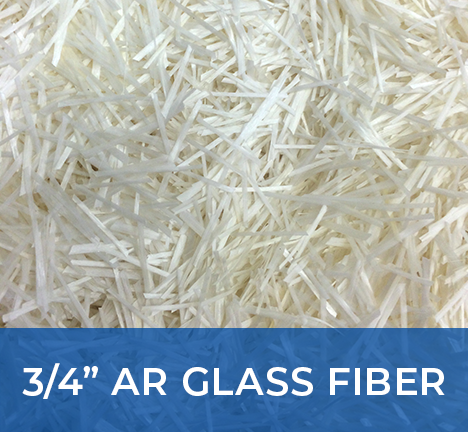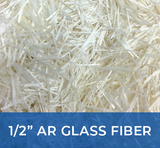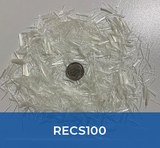
3/4" AR Glass Fibers (19mm)
OC Glass Fiber - (9kg - 19.8 lb) Owens Corning
3/4" Bundled fiber for GFRC.
Advantages:
Type of Glass: Alkali Resistant, high Zirconia Content
Highest Integrity During Mixing, Best Flow Characteristics
Filament Diameter μ18
Filaments per Strand 200
Zirconia Content Minimum 17%
Moisture Content < 0.5%
OC offers the AR glassfiber with the highest zirconia content available.
All OC alkali resistant glass fiber products are manufactured in compliance with ASTM C1666/C 1666M, EN 15422 and under recommendations of PCI and GRCA.
Glass Fiber Reinforced Concrete – ¾” verses ½” in Self Consolidating GFRC
A first glance the answer seems simple: ¾” fiber will develop a better bond due it the longer length resulting in higher flexural strength vs. and equal dosage of ½” fiber.
One thing I’ve learned from 35 years of testing is never assume you know the answer without testing. We’ve invested 50K in lab equipment so we could dig a little deeper to find answers.
The mixes were both made with Trinic’s TEC-10 admix and are about 25% higher than results typical of liquid polymers.
The results show just about equal flexural strength (ASTM C-947-3) between ½” and ¾” Owens Corning Cem-Fil 60 Glass fiber in Self Consolidating premix GFRC made with Trinic's TEC-10 Admixture.
There are however advantages to both lengths:
• ¾” OC fiber tends to hang better on vertical walls
• ½” OC fiber flows better than ¾” OC fiber, making it a better choice in SCC mixes.
• Both sizes of Owens Corning Cem-Fil 60 glass fiber have lower water demand than competitive fiber.
• Owens Corning Cem-Fil 60 has better abrasion resistance (less likely to break up during mixing).
Based on the results Trinic recommends ¾” Owens Corning Cem-Fil 60 glass fiber for vertical hand pack applications and flat SCC pours (so you don’t need to stock two sizes) with ½” Owens Corning Cem-Fil 60 glass fiber recommended for SCC pours, especially vertical castings into small openings.
Mark C, Trinic
We Also Recommend


